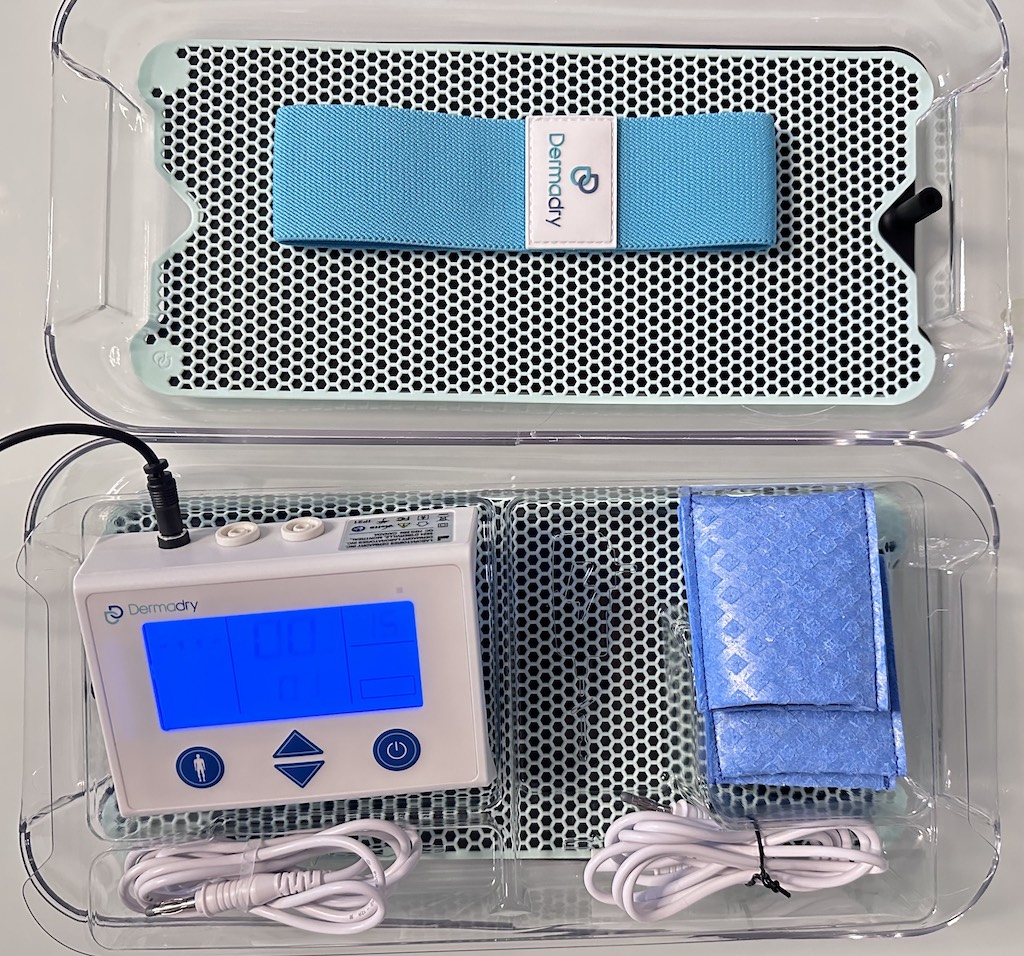You’ve tried antiperspirants, wipes, and they didn’t work for you. So now you’re about to give iontophoresis a shot?
You should, because it works great!
But the reality of doing a iontophoresis session is not as nice and easy as advertising makes it seem! So before you get started, you need to be mentally prepared about what it’s really like. I did sessions several times a week for years, so I’ll walk you through the steps.
Why iontophoresis?
First, because iontophoresis works for at least 80% of people with palmar hyperhidrosis (according to a 2002 study).
Also, because iontophoresis has less disadvantages than the other hyperhidrosis treatments options because it’s:
- Safer than ETS surgery
- More effective than antiperspirants or solutions
- Cheaper than botox
If you haven’t tried using an iontophoresis machine to treat your hyperhidrosis yet, you should.
So these machines work great, but you need to know what you’re getting yourself into. It’s gonna require work.
What is a iontophoresis machine?
Basically, you fill trays with water (1 tray per hand or foot) and you connect these trays to the main machine with some cords. Once you put your hands/feet in the water and turn the machine on, it’s gonna send electric current through your skin.
If you’d like to know more about the pros and cons of hyperhidrosis machines, check this article.

Where can I find a video of what a session looks like?
I strongly recommend you go on Youtube and type in ‘iontophoresis machine’ to see the videos that different brands posted. Check several brands’ videos and that will give you a good overview of what a session looks like.
There are a lot of different brands, with slightly different instructions, but it’s essentially the same process with all of them.
Most videos I found were annoying, either too clinical or they seemed to have been made by paid bloggers. But either way, I’m not gonna be a Debbie Downer, that’s still helpful info, right!?
I found a video that does not have annoying voice-over and is pretty straightforward:
The real steps behind an iontophoresis session and what you don’t see in ads
So you’ve watched a few videos and you are like “OMG, these machines look scary”. Yep, they do.
But no worries, you are not alone in this! We are all in the same boat! And it’s worth trying if it can help stop the sweaty feet and hands, right?
In the below table, you can see the different steps it takes to go through the treatment, one column for the ‘official’ steps, and one column for ‘behind the scenes’ steps 🙂
| OFFICIAL USUAL STEPS | WHAT YOU NEED TO KNOW | |
| BEFORE THE SESSION | Place a sheet of metal + plastic provided in each plastic tray | You need to place a towel next to you now to dry yourself up at the end |
| Fill the trays with water | Put a TV show on (a iontophoresis session lasts 20 minutes, so once your feet and/or hands are stuck in water the show will keep you busy – instead of staring at the wall!) | |
| Fill the trays with water | Make sure the water is not too cold or too hot (sounds silly when you read it but trust me, it’s easy to forget), and make sure the water will cover the top of your hand or feet | |
| They make it seem easy on videos to get water into the trays. But since you need to be doing this several times a week, you will probably have the machine set in a specific room (living room, bedroom, etc.) so make sure you have a bucket or something to carry the water from the bathroom to the machine (before and after the session). | ||
| Connect the trays to the machine with the black and red cords | ||
| Plug the machine (do not start current yet) | Put a TV show on (an iontophoresis session lasts 20 minutes, so once your feet and/or hands are stuck in water the show will keep you busy – instead of staring at the wall!) | |
| Remove all your hand/feet jewelry | ||
| Put Vaseline on all cuts or irritations you may have on your hand/feet | ||
| Select the level of ampere (the intensity of electricity you will feel) | When you start iontophoresis sessions, you are not used to the stinging yet, so you usually start super small. Then see how you feel, and increase the intensity session after session until you reach the maximum level you are comfortable with. | |
| Place your hands/feet in the trays | ||
| DURING THE SESSION | Turn it on! (using the knob, button or whatever is on that machine) and quickly put your hands/feet in the water if you haven’t already | During those 20 minutes, the iontophoresis machine will do its thing and slowly bring the electricity up to the level you selected, then down, then back up, etc. |
| Option 1: Wait 20 minutes Option 2: Wait 10 minutes, switch cables, and do it 10 more minutes | Make sure the water is not too cold or too hot (sounds silly when you read it but trust me, it’s easy to forget), and make sure the water will cover the top of your hand of feet | |
| This is when you are happy you put a TV show on | ||
| Do NOT get your hands/feet out of the water (or you will get an electric shock ☹ The pain is manageable but still painful.) | ||
| If you need to scratch your nose (it happens every time you can’t scratch it, right? 😊) then either: -Ask someone to bring the ampere button down to zero, scratch your nose, and then bring it back to where it was. -OR if you are by yourself (like I was most of the time), use your chin/mouth or else to turn it off, scratch your nose, and put turn the electricity on again. (I wish they made it easier to stop the machine in the middle of a session…) | ||
| The machine rings, it’s over! | ||
| AFTER THE SESSION | Take your hands/feet out of the water | |
| Dry your hands and feet | It’s now clean up time: empty the water from the trays to the bucket and go throw the water. | |
| Dry the cords, trays and sheets. Otherwise, they risk to rust. |
Stick to it and be patient
It seems like a lot of steps, and seems overwhelming. That’s normal! But like many things in life, the more you do something, the more it becomes just a routine. You’ll get used to it. You need to do it a few times a week, so you will quickly get used to it.
To make it a bit less annoying, try to tie that ritual to something you enjoy. If you prefer to do it in the morning, maybe you do your iontophoresis sessions while watching or listening to the morning news? Or if you prefer evenings, maybe you use these sessions to catch up on your favorite Netflix show? Or maybe you treat yourself with a nice shower or bath afterwards?
Make sure you stick to that ritual a few times a week, and then only you’ll start seeing results. It takes a few weeks to start feeling the effects of the treatment, so please be patient, and you will finally be able to rub your hands! (the ultimate fantasy when you have hyperhidrosis, right!? 🙂 )
If you would like to learn more, check this article about iontophoresis pros and cons.





Pingback: Treat hyperhidrosis with Iontophoresis: the pros and cons
If it wasn’t for these advantages and the change to get rid of the “wet problem” easily, who knows what would I have done, it really works. The device that I got helped me to return to normal life. Somebody can get upset about few droplets on the forehead, but sweaty hands are the real nightmare.